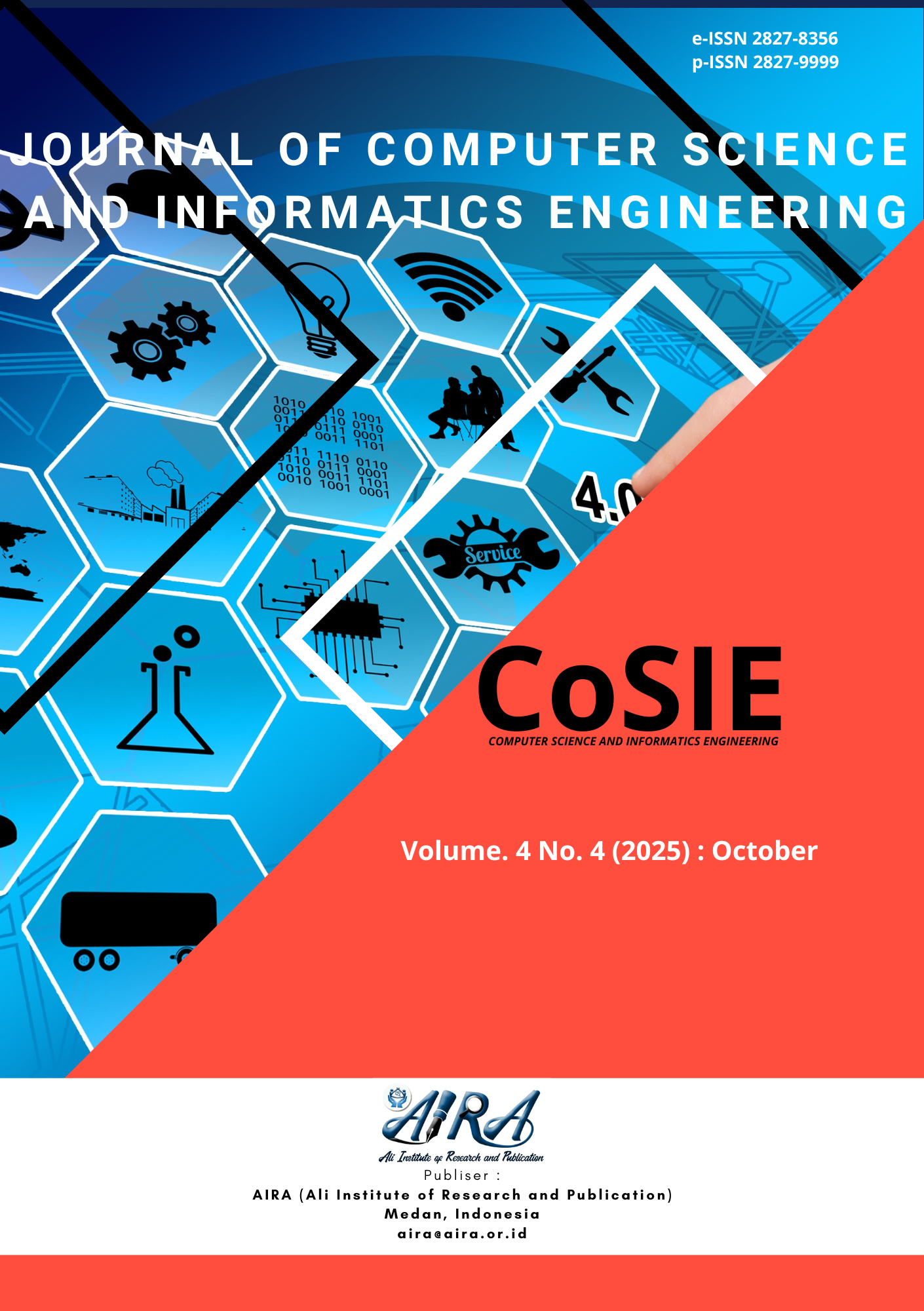Classification of Nutritional Status in Toddlers Based on Anthropometric Data Using Random Forest
DOI:
https://doi.org/10.55537/cosie.v4i4.1175Keywords:
machine learning , stunting, nutritional status, classification, Random ForestAbstract
Stunting is a chronic nutritional problem that remains a major challenge in improving child health in Indonesia. This condition has long-term impacts on physical growth, cognitive development, and future productivity of children. Early detection of toddlers' nutritional status is crucial for effectively preventing and addressing stunting cases. This study aims to develop a machine learning-based classification model for toddlers' nutritional status using simple anthropometric data, namely age (in months), sex, and height (in cm). The dataset used in this study was sourced from the 2022 historical records of the Health Department and the Community-Based Nutrition Recording and Reporting System (E-PPGBM), comprising 120,999 entries categorized into four nutritional status classes: normal, tall, stunted, and severely stunted. Data preprocessing included label encoding and feature standardization. The model employed is the Random Forest Classifier, evaluated using accuracy, precision, recall, and F1-score metrics. The training results show that the model achieved a classification accuracy of 99.93% on the test data, with F1-scores for each class as follows: Normal = 0.9998, Severely Stunted = 0.9985, Stunted = 0.9975, Tall = 0.9997. Feature importance analysis indicates that height is the most influential feature in the classification task. These findings demonstrate that machine learning algorithms, particularly Random Forest, are effective for predicting toddlers’ nutritional status and have strong potential to be integrated into digital applications that support Indonesia’s stunting reduction programs. However, the model's limitation lies in its use of only basic anthropometric features—age, sex, and height—without considering additional variables such as weight, disease history, dietary patterns, socioeconomic status, or immunization history, which may also influence a child's nutritional status. To improve the model's accuracy and relevance, it is recommended to incorporate other related features, such as body weight, nutritional intake, health history, and social-economic indicators, in future research.
Downloads
References
[1] Fatmawati, M.,Herlambang, B.A.,& Nada, N.Q.(2024). Random forestalgorithm for toddler nutritional status classification website. Journal of Applied Informatics and Computing, 8(2), 428-433.
[2] Gustriansyah, R., Suhandi, N., Puspasari, S., & Sanmorino, A. (2024). Machine learning method to predict the toddlers’ nutritional status. Indonesian Journal of Artificial Intelligence and Data Mining, 7(1), 23-32.
[3] Reza, A. A., & Rohman, M. S. (2024). Prediction stunting analysis using random forest algorithm and random search optimization. Journal of Informatics and Telecommunication Engineering, 7(2), 110–117.
[4] Lestari, W. S., Saragih, Y. M., & Caroline. (2024). Comparison of deep neural networks and random forest algorithms for multiclass stunting prediction in toddlers. Teknika, 13(3), 412–417.
[5] Marpaung, S. H., Handoko, E., & Anggraeni, I. R. (2024). Random forest optimization using recursive feature elimination for stunting classification. Indonesian Journal of Artificial Intelligence and Data Mining, 7(1), 45–54.
[6] Dewi, Y. S., Hastuti, S., & Fatekurohman, M. (2024). Analysis of stunting in East Java, Indonesia using random forest and geographically weighted random forest regression. Brazilian Journal of Biometrics, 42(3), 213–224.
[7] Hasdyna, N., Fitriani, Y., & Sari, D. P. (2024). Hybrid machine learning for stunting prevalence: Classification, prediction, and clustering in Aceh, Indonesia. Informatics, 11(4), 89.
[8] Rao, B., Rashid, M., Hasan, M. G., & Thunga, G. (2025). Machine learning in predicting child malnutrition: A meta analysis of demographic and health surveys data. International Journal of Environmental Research and Public Health, 22(3), 449.
[9] Wara, T. U., Mahmud, T., & Joy, C. D. (2024). Risk factor identification and classification of malnutrition among under five children in Bangladesh: Machine learning and statistical approach. arXiv preprint.
[10] Pramana, A. A. G. Y., Zidan, H. M., Maulana, M. F., & Natan, O. (2024). ESDS: AI powered early stunting detection and monitoring system using Edited Radius SMOTE algorithm. arXiv preprint.
[11] Nishimwe, B. A., Munyanshongore, C., & Hakizimana, J. (2023). Stunting prediction in under-five children using logistic regression and random forest: Evidence from Rwanda. African Journal of Health Sciences, 36(1), 45–56.
[12] Yusuf, S., & Abdurrahman, A. (2023). Predicting child undernutrition using ensemble machine learning: A case from Indonesia. International Journal of Health Sciences and Research, 13(2), 87–94.
[13] Children. (2023). Machine learning algorithms for predicting stunting among under-five children in Papua New Guinea. Children, 10(10), 1638.
[14] Lestari, W. S., Saragih, Y. M., & Caroline. (2025). Multiclass classification for stunting prediction using deep neural networks. Jurnal Ilmu Teknologi Komputer, 10(2), 386–393.
[15] Hossain, M., Ahmed, S., & Huda, T. (2022). Predictive modeling of child malnutrition using artificial intelligence techniques: A systematic review. Journal of Public Health Informatics, 14(1), e123.
[16] Mundirin, Mundirin, and Joko Prasetiana. "The tidal station management application (PAS)." Journal of Information System, Applied, Management, Accounting and Research 6.1 (2022): 232-239.
Downloads
Published
How to Cite
Issue
Section
License
Copyright (c) 2025 Mundirin Imung, Idawati Idawati, Ibrahim Latief

This work is licensed under a Creative Commons Attribution-ShareAlike 4.0 International License.






